Do you remember the taste of succulent, juicy tomatoes that your grandparents used to grow in their backyard? Or the flavor of a traditionally raised turkey?
As the world continues to modernize, the taste of the past is slowly fading away. But there is a way to bring back that flavor and experience—heirloom plants and heritage turkeys.
Heirloom is the term used for plants with a long history, while heritage is the word usually reserved for livestock. Heritage turkeys are a step back in time, offering a taste of how poultry was before industrialization. Unlike regular turkeys, heritage turkeys are bred for flavor, texture, and nutrition.
This article will focus on heritage breeds and their unique characteristics, taste, and cost. By the end of this article, you will better understand the differences between heritage and store-bought turkeys and how to choose the best one for your holiday meal. Let’s get started!
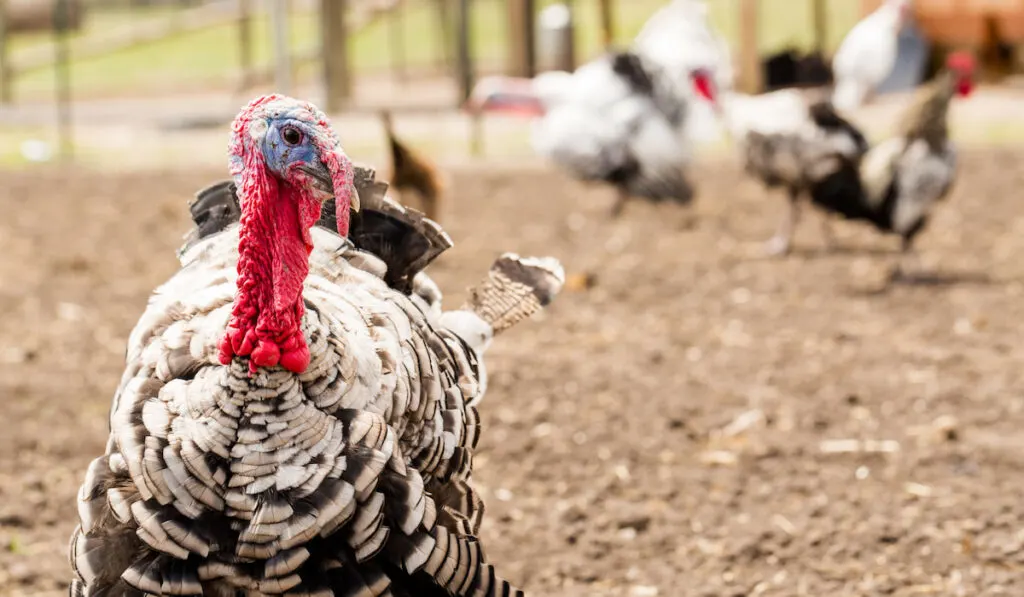
Table of Contents
Are Heirloom and Heritage Different Breeds?
Heirloom and heritage aren’t different turkey breeds. Technically, “heirloom” is used for plants and “heritage” for animals, but some people use the terms interchangeably with turkeys.
Heirloom plant breeds possess genetic traits passed down through generations and carefully preserved over time.
Conversely, heritage breeding aims to maintain specific characteristics, but they are not necessarily part of an original set of traits.
According to Livestock Conservancy, a turkey must meet strict criteria to be labeled as heritage. These criteria include having a long, productive lifespan, a slow growth rate, and the ability to mate naturally.
Heritage turkeys are breeds of domesticated turkeys genetically similar to the wild turkeys in North and South America. The turkeys offer a more flavorful and richer taste than regular store-bought turkeys.
Furthermore, heritage turkeys are popular for their premium quality, high-fat content, and deep red dark meat color. Unlike store-bought turkeys, heritage turkeys are free-range and are raised in much smaller numbers.
Breeds of Heritage Turkeys
| Breed | Coloring | Weight |
| Narragansett | A unique combination of white, black, and bronze. | Tom: 22–28 lbs. Hen: 12–16 lbs. |
| Blue Slate | Slate-blue feathers. It can range from a light blue to a deep or steel-blue color. | Tom: 24 lbs. Hen: 14 lbs. |
| Royal Palm | A pattern of white and metallic black edging. | Tom: 22 lbs. Hen:12 lbs. |
| Chocolate | Brown or chocolate spotting | Tom: 24–28 lbs. Hen: 14–16 lbs. |
| Midget White | Shades of whites and grays | Tom: 13 lbs. Hen: 8–10 lbs. |
Narragansett Turkey
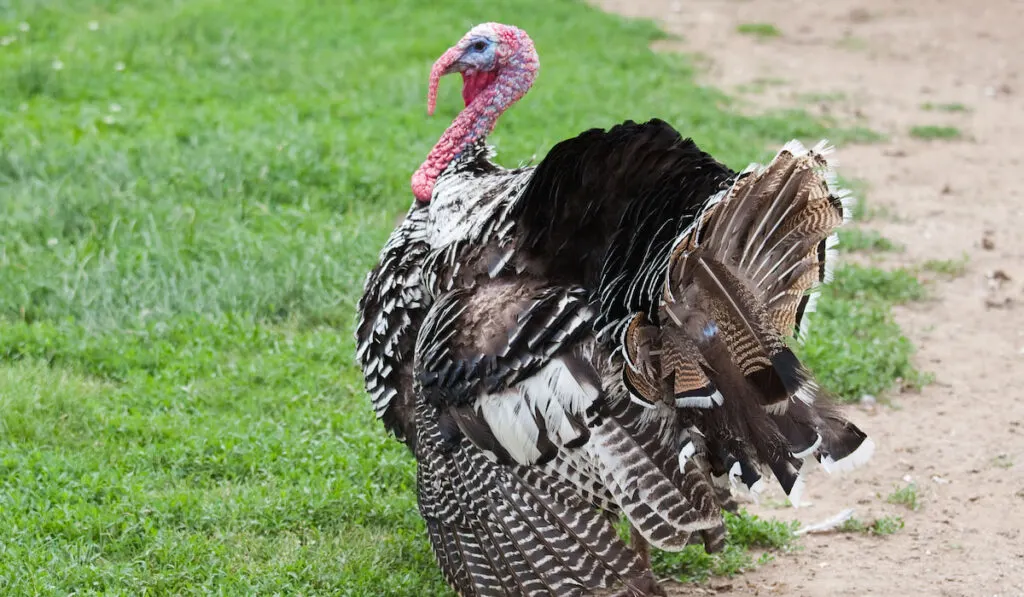
The Narragansett turkey is an American heritage breed that originated in Rhode Island in the early 1700s. This breed is hardy, adaptable, and has a rich flavor.
Narragansetts are medium-sized birds, with hens weighing up to 16 pounds and toms up to 28 pounds.
The Narragansett is a dual-purpose breed excellent for both meat and egg production. This breed is a great choice for those looking for a heritage turkey with a unique flavor and appearance.
Blue Slate Turkey
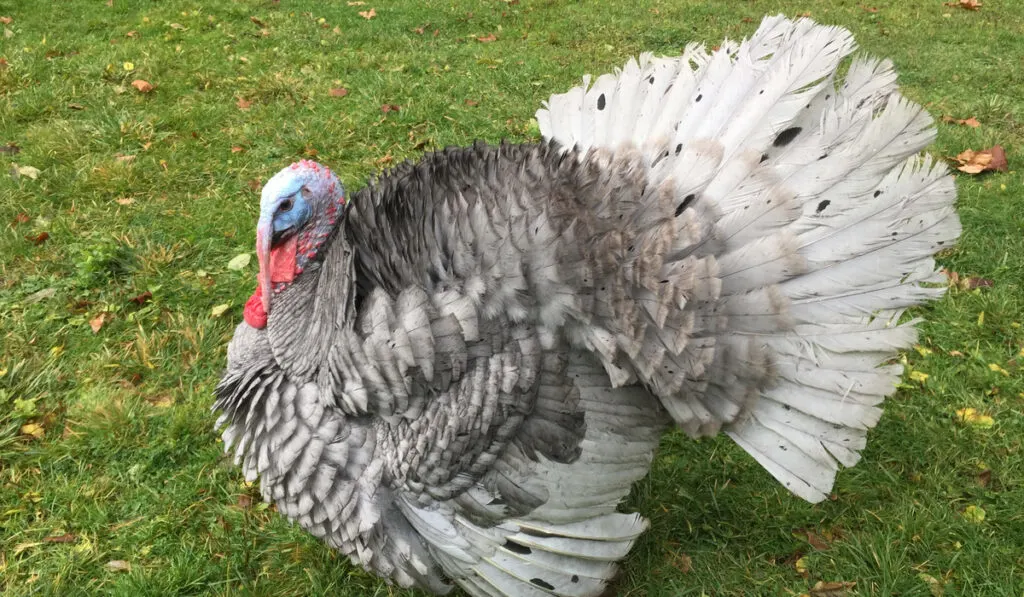
The Blue Slate turkey is a rare heritage breed from Mexico, first mentioned in the 1800s. It is a medium- to large-sized heritage bird with a unique slate-blue color and white barring on the neck and tail feathers.
The tom of the species is darker than the hen and can weigh up to 27 pounds.
Blue Slate turkeys are popular for their hardiness and foraging ability. This makes them a great choice for free-range farming.
Royal Palm Turkey
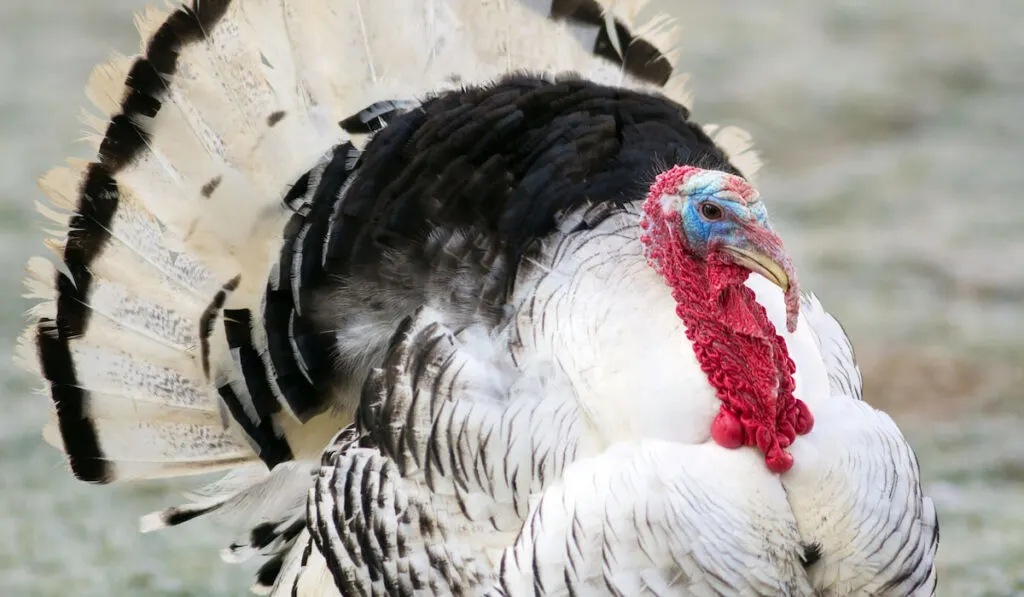
The Royal Palm turkey’s pattern of white and black feathers creates a striking visual. It is a smaller breed, weighing around 12–22 pounds, and is often kept as an ornamental bird.
The Royal Palm turkey is an active breed that flies and roosts in trees. It is also a hardy breed that can tolerate extreme temperatures and is thus a good forager.
Chocolate Turkey
The Chocolate turkey is easily recognizable by its dark brown feathers. It is a large bird, weighing 14–28 pounds, with chocolate-spotted plumage. It has a mild flavor and is leaner than other heritage breeds.
A Chocolate turkey is hardy and can thrive in various climates. It is also known for its excellent taste and can be a great addition to any holiday feast.
Midget White Turkey
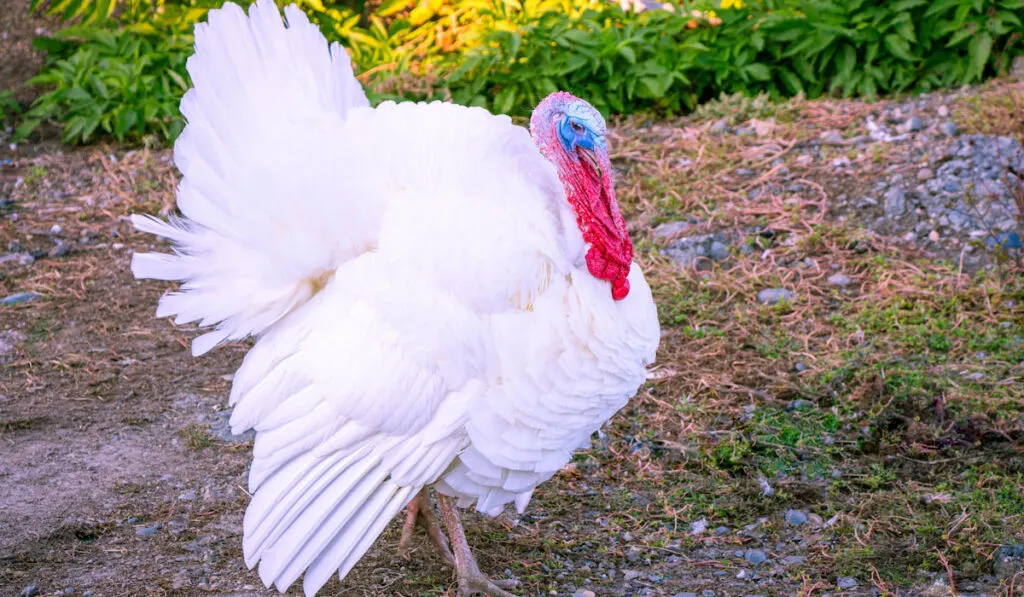
The Midget White turkey is a cross between the Royal Palm and commercial white turkeys. It is a small, hardy bird and a good choice for small farms and backyard flocks.
The Midget White is a good choice for free-range production. This is because of its excellent foraging ability, and it can withstand cold temperatures.
Midget Whites have a calm disposition, and the hens are good mothers.
A Midget White is ideal if you’re looking for a small, hardy bird that can provide a good percentage yield of breast meat.
Do Heritage Turkeys Taste Better than Regular Turkeys?
Heritage turkeys taste better than regular turkeys.
This is mainly due to their higher quality of nutrition, flavor, and texture. Their raising is more humane, and their diets usually consist of organic grain and pasture-raised feed. This results in more flavorful and healthy meat.
From my experience, both heritage and regular turkeys have unique flavor profiles. Heritage turkeys tend to be more robust, with a deeper and richer earthly flavor. The meat is also more tender, thanks to its slower growth rate.
On the other hand, regular turkeys have a milder flavor, with a lighter and slightly sweeter taste.
Through my research, I have also found that heritage turkeys are higher in nutrients, including more omega-3 fatty acids, zinc, and vitamins.
Ultimately, the flavor of each turkey depends on the breed, the feed, and the cooking method.
It’s best to slow-cook your heritage turkeys at a lower temperature to get the most out of them. Slow cooking at a low temperature will allow the bird’s flavors to develop to perfection.
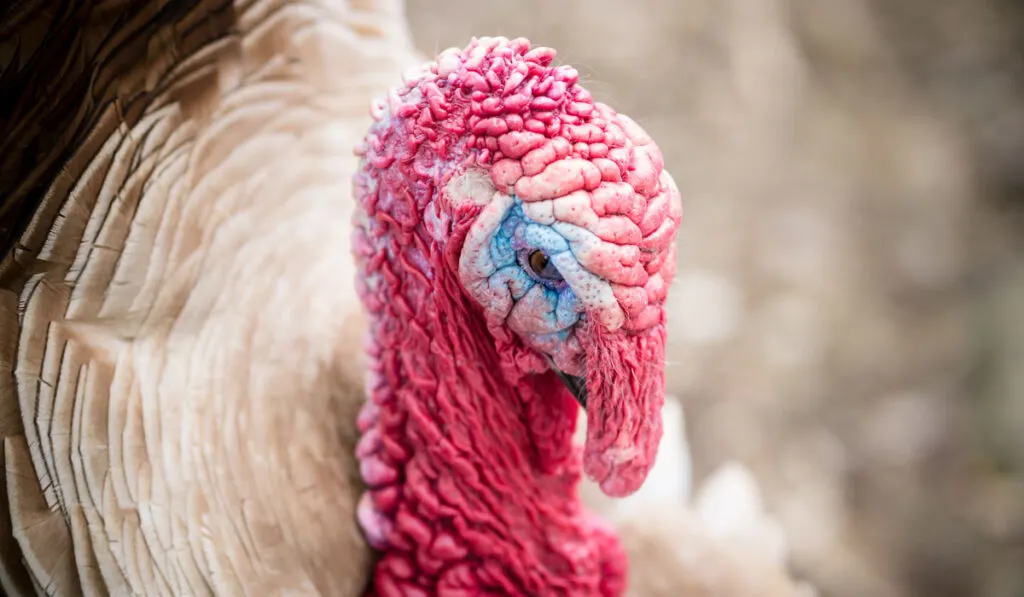
Are Heritage Turkeys More Expensive?
Heritage turkeys are generally more expensive than regular turkeys.
According to the Atlantic, regular turkeys are typically available for around $1.50 per pound, while heritage turkeys can cost about $7 per pound.
While the price difference may seem steep, remember that the cost of heritage turkeys includes the extra labor and care that goes into raising these birds.
The breeding of heritage turkeys aims to increase their quality, flavor, texture, size, and weight. This results in a higher price per pound compared to store-bought turkeys.
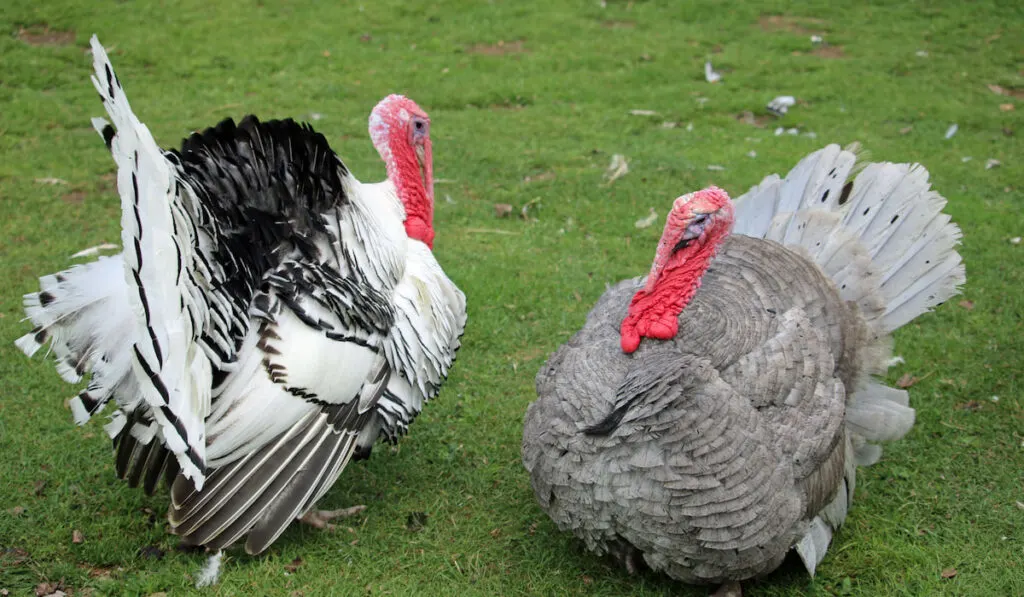
Conclusion
When choosing between heritage and store-bought turkeys, it is important to consider the following:
- Cost
- Flavor
- Texture
- Overall quality
Heritage turkeys are excellent options for a unique, flavorful, and high-quality bird. However, it is important to remember that these birds have a higher price tag.
Ultimately, the decision is yours to make. So, tempt your palate with the exquisite flavors of both turkeys, and choose a delight you’re sure to enjoy!
Resources
- https://livestockconservancy.org/heritage-turkey-definition/
- https://blog.mcmurrayhatchery.com/2022/03/27/heritage-and-production-turkeys/
- https://backyardpoultry.iamcountryside.com/poultry-101/narragansett-turkey-breed-profile/
- https://www.agriculture.com/livestock/poultry/blue-slate-turkey-profile_287-ar13323
- https://www.hmdb.org/m.asp?m=195216
- https://www.porterturkeys.com/chocolateslate.htm
- https://www.roysfarm.com/midget-white-turkey/
- https://www.medicalnewstoday.com/articles/285736
- https://www.theatlantic.com/health/archive/2010/11/heritage-turkeys-worth-the-cost/66727/
